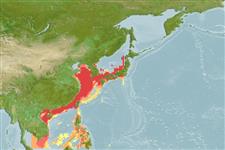इलाज़मौबरांकी (शारक और रेज़) (sharks and rays) >
Orectolobiformes (Carpet sharks) >
Orectolobidae (Carpet or nurse sharks)
Etymology: Orectolobus: orektos (Gr.), stretched out; lobus (L.), from lobos (Gr.), rounded projection or protuberance, referring to long nasal barbels of Squalus barbatus (=O. maculatus). (See ETYFish); japonicus: -icus (L.), belonging to: Japan, described from two specimens, both from Japan. (See ETYFish).
More on author: Regan.
Environment: milieu / climate zone / depth range / distribution range
पारिस्थितिकी
समुद्री ड़िमरसल; गहराई सीमा 0 - 200 m (Ref. 106604). Tropical; 43°N - 6°N, 103°E - 140°E
Western Pacific: Japan and Korea to Viet Nam.
Length at first maturity / आकार / वज़न / Age
Maturity: Lm ?, range 103 - ? cm
Max length : 118 cm TL पुल्लिंग / अलिंग; (Ref. 106604)
पृष्ठीय रीढ़ (सम्पूर्ण) : 0; गुदा कांटा: 0. Five to six dermal flaps below and in front of eyes; back with light areas between dark saddles marked with broad reticulated dark lines (Ref. 13577). Caudal fin with its upper lobe hardly elevated above the body axis, with a strong terminal lobe and subterminal notch but no ventral lobe (Ref. 13577).
A little-known bottom shark found inshore (Ref. 247); usually in sand or sandy mud bottoms (Ref. 11230); also on rocky and coral reefs (Ref. 43278). Nocturnal in habits (Ref. 247). Feeds on fish and presumably bottom invertebrates (Ref. 247), including lizardfishes, cutlassfish, horse mackerel and other jacks, goatfishes, groupers, tilefishes, sea robins, whiting, parrotfishes, sea bream, croakers, also skates, shark egg cases, cephalopods, and shrimp (Ref. 43278). Ovoviviparous (Ref. 43278, 50449), with up to 20 young in a litter (Ref. 247). Wobbegongs should be regarded as potentially dangerous because of its formidable dentition (Ref. 247, 13577). Used for human consumption (Ref. 247). Kept in aquaria in Japan and the United States (Ref. 43278).
Life cycle and mating behavior
Maturities | पुनरुत्पत्ति | Spawnings | Egg(s) | Fecundities | लार्वा
Ovoviviparous, embryos feed solely on yolk (Ref. 50449). With up to 20 young in a litter (Ref. 247).
Compagno, L.J.V., 1984. FAO Species Catalogue. Vol. 4. Sharks of the world. An annotated and illustrated catalogue of shark species known to date. Part 1 - Hexanchiformes to Lamniformes. FAO Fish. Synop. 125(4/1):1-249. Rome, FAO. (Ref. 247)
IUCN Red List Status (Ref. 130435)
Human uses
मात्स्यिकी: लघु वाणिज्य
साधन
Special reports
Download XML
इंटरनेट स्रोत
Estimates based on models
Preferred temperature (Ref.
123201): 14.5 - 27.7, mean 24 °C (based on 222 cells).
Phylogenetic diversity index (Ref.
82804): PD
50 = 0.5012 [Uniqueness, from 0.5 = low to 2.0 = high].
Bayesian length-weight: a=0.00389 (0.00180 - 0.00842), b=3.12 (2.94 - 3.30), in cm total length, based on all LWR estimates for this body shape (Ref.
93245).
Trophic level (Ref.
69278): 3.8 ±0.57 se; based on food items.
लौटाव (Ref.
120179): निम्न, न्यूनतम जनसंख्या दुगनी होने का समय 4.5 - 14 वर्ष। (Fec=20).
Fishing Vulnerability (Ref.
59153): High to very high vulnerability (71 of 100).
